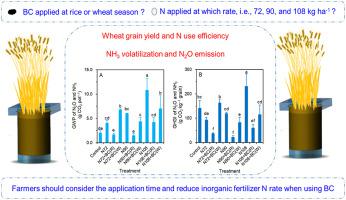Environmental Pollution ( IF 7.6 ) Pub Date : 2022-05-02 , DOI: 10.1016/j.envpol.2022.119409
Yu Zhang 1 , Paramsothy Jeyakumar 2 , Changlei Xia 3 , Su Shiung Lam 4 , Jiang Jiang 1 , Haijun Sun 1 , Weiming Shi 5

|
Biochar (BC) application to agricultural soil can impact two nitrogen (N) gases pollutants, i.e., the ammonia (NH3) and nitrous oxide (N2O) losses to atmospheric environment. Under rice-wheat rotation, applied at which growth cycle may influence the aforementioned effects of BC. We conducted a soil column (35 cm in inner diameter and 70 cm in height) experiment to evaluate the responses of wheat N use efficiency (NUE), NH3 volatilization, and N2O emission from wheat season to biochar applied at rice (R) or wheat (W) growth cycle, meanwhile regarding the effect of inorganic fertilizer N input rate, i.e., 72, 90, and 108 kg ha−1 (named N72, N90, and N108, respectively). The results showed that BC application influenced the wheat growth and grain yield. In particular, BC applied at rice season increased the wheat grain yield when receiving 90 and 108 kg N ha−1. The improved wheat grain yield was attributed to that N90 + BC(R) and N108 + BC(R) enhanced the wheat NUE by 53.8% and 52.8% over N90 and N108, respectively. More N input led to higher NH3 volatilization and its emission factor. Interestingly, 19.7%–34.0% lower NH3 vitalizations were recorded under treatments with BC applied in rice season, compared with the treatments only with fertilizer N. BC applied at rice season exerted higher efficiency on mitigating N2O emission than that applied at wheat season under three N input rates, i.e., 60.5%–77.6% vs 29.8%–34.8%. Overall, considering the crop yield and global warming potential resulting from NH3 volatilization and N2O emission of wheat season, N90 + BC(R) is recommended. In conclusion, farmers should consider the application time and reduce inorganic fertilizer N rate when using BC.
中文翻译:

在水稻或小麦季节施用会影响生物炭对小麦生长周期中气态氮污染物的影响
将生物炭 (BC) 应用于农业土壤会影响两种氮 (N) 气体污染物,即氨 (NH 3 ) 和一氧化二氮 (N 2 O) 向大气环境的损失。在稻麦轮作下,在哪个生长周期施用可能会影响上述 BC 的效果。我们进行了土壤柱(内径 35 cm,高度 70 cm)试验,以评估小麦氮利用效率(NUE)、NH 3挥发和小麦季节 N 2 O 排放对水稻施用生物炭(R ) 或小麦 (W) 生长周期,同时关于无机肥 N 投入率的影响,即 72、90 和 108 kg ha -1(分别命名为 N72、N90 和 N108)。结果表明,BC施用影响小麦生长和籽粒产量。特别是,在稻季施用 BC 在接受 90 和 108 kg N ha -1时增加了小麦籽粒产量。小麦籽粒产量的提高归因于 N90 + BC(R) 和 N108 + BC(R) 分别比 N90 和 N108 提高了 53.8% 和 52.8% 的小麦 NUE。更多的N输入导致更高的NH 3挥发及其排放因子。有趣的是,与仅施肥 N 的处理相比,在水稻季节施用 BC 处理记录的NH 3活化降低了 19.7%–34.0% 。在水稻季节施用 BC 对减轻 N 2的效率更高在三种氮投入率下,O 排放量均高于小麦季节,分别为 60.5%–77.6%和29.8%–34.8%。总体而言,考虑到小麦季节NH 3挥发和N 2 O排放导致的作物产量和全球变暖潜能值,推荐使用N90 + BC(R)。综上所述,农民在使用生物炭时应考虑施用时间,降低无机肥施氮量。































 京公网安备 11010802027423号
京公网安备 11010802027423号